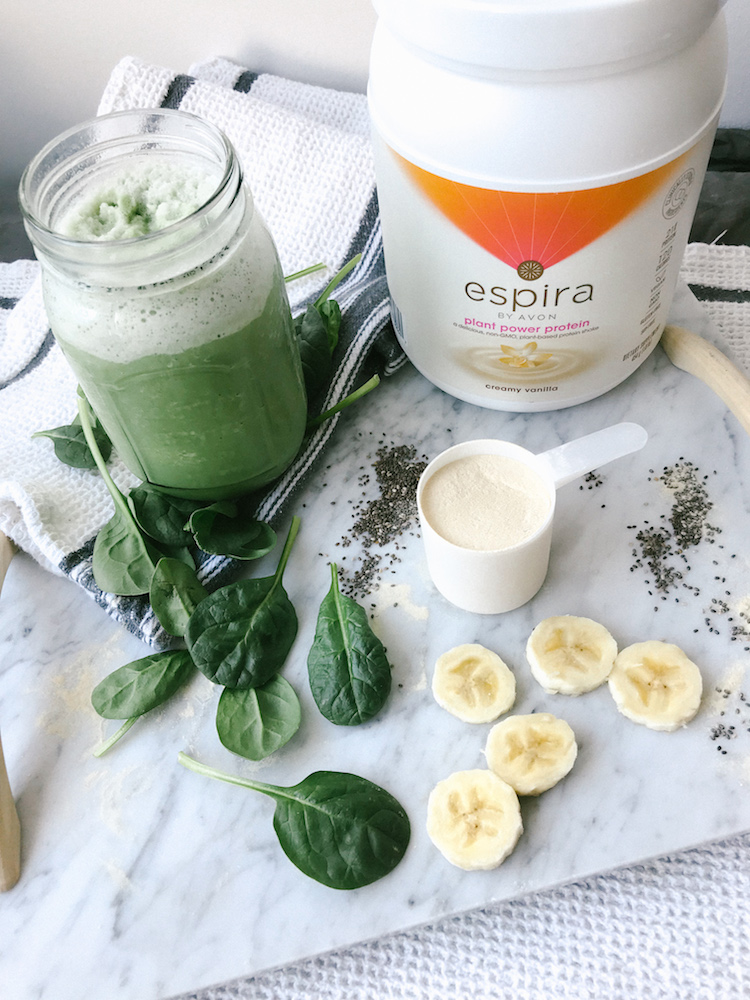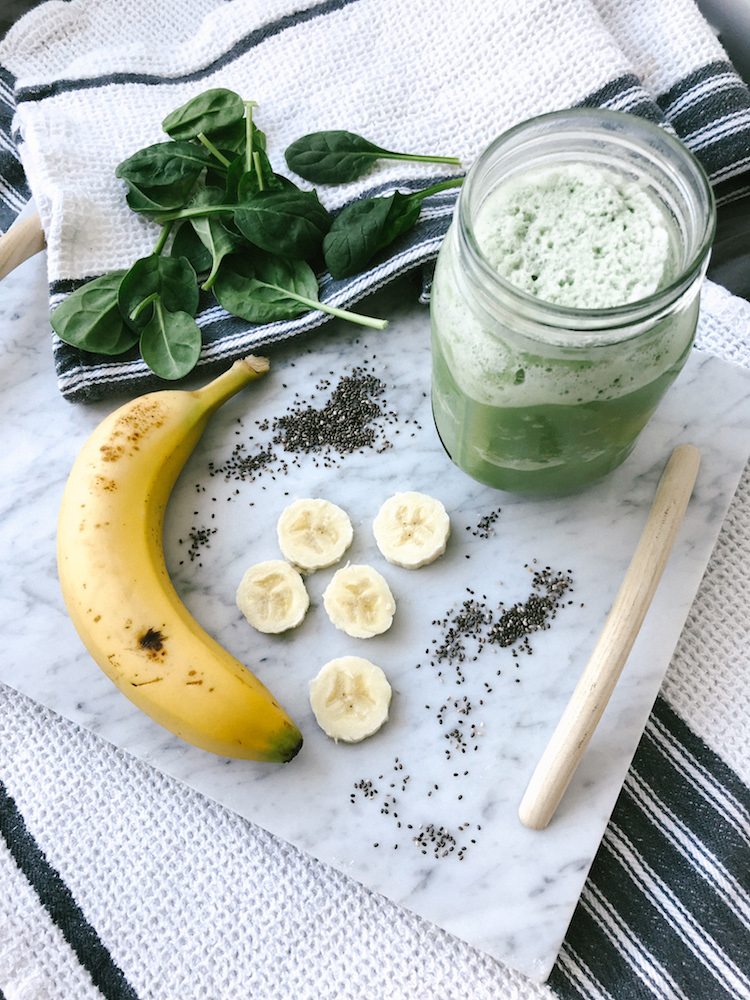

On most days, especially after I’ve worked out and feeling like I need a bit more of energy, I try to make myself either a smoothie or protein shake. If I’m having it first thing in the morning or after working out, I’ll make it using the “Fab Four” approach which I’ve briefly mentioned here. It’s basically a combo of greens (I like baby spinach), fat (coconut oil or a nut butter), fiber (chia seeds), and a source of protein (Espira Plant Power Protein). On days when I have a smoothie as a snack, I’ll omit the nut butter because chances are that I’ve already consumed some earlier in the day (as I always do).
Espira by AVON Plant Power Protein
One of the main ingredients that remains consistent is the Espira by AVON Plant Power Protein. If you follow my stories on Instagram, then you’ve probably watched me mention it several times, because it’s really that good. I appreciate that the ingredients are all natural (no dairy, soy, or gluten) and that the powder never leaves that yucky chalk taste behind, as so many other powders do. To be completely honest, the entire Espira by AVON range is truly wonderful and this partnership ended up happening because I was singing their praises on my own.
Smoothie/Protein Shake Recipe:
- 2 large handfuls of baby spinach
- 2 tablespoons of chia seeds for fiber
- 1 serving of Espira by AVON Plant Power Protein Powder (vanilla or chocolate)
- 1-1.5 cup of unsweetened nut milk
- 1-2 teaspoons of nut butter, which I omit If I already had for breakfast. Somedays I’ll sub with PB Fit.
- I like to add a some cocoa powder or some cinnamon for an added flavor boost.
- 1/4 a banana, frozen or room temp.
- Ice
Play around with the ingredients to see which combo you like best! I always find it so filling and delicious.

Aside from sharing this smoothie recipe, I wanted to share a wonderful Q&A that I had with Ashley Koff, RD Espira by AVON’s nutritionist. Two weeks ago, a bunch of you sent in questions that you wanted me to ask her. We didn’t get around to answering all of them (there were so many!). But we got to a lot of great ones.
Q: Is olive oil OK to use & cook with?
A: Yes, cooking with olive oil is fantastic! Not all olive oils are created equal. So I do look for an extra virgin olive oil or ones that are from California to cook with. What you want to do in order to make it healthier is to cook with it at a lower temperature, not at high. Keep it mind that if you’re cooking with olive oil. Some of that fat is coming in, but it’s very good for you because it’s activating your body to absorb those nutrients.
Additionally, the rumor that when you add heat to olive oil it loses its nutrition value is NOT true. Every oil has a burn point, so you want to keep things below that by cooking at a lower heat.
Q: What is the right balance of carbs to eat with a healthy diet while having energy for workouts and muscle/tone building?
A: Sometimes things can feel at a conflict with diet & working out, which can get confusing. The easy thing to do, when trying to build/maintain or gain more energy, is balance your body with the ‘4 parts of better nutrition.’ These are carbohydrates, proteins, healthy fats, and non-starchy vegetables. The goal is to do is get one serving of each of those in, at each of your pit stops during the day.
Think about it as a better quantity of better quality nutrients, in balance, more often. There are certain carbohydrates that are going to be better for us. Especially ones found in nature and not super refined. So where white flour/sugar probably isn’t the best option, half of a sweet potato would be considered a healthier choice. The key is then pairing that better carb with the proteins, healthy fats, and non-starchy vegetables.
Q: Sometimes I feel like some food triggers major bloating. Is that because of an allergy? What’s the most excellent way to de-bloat?
A: This is a big one, especially for us ladies because we’re more focused on it than men are. One of the key things for us to think about is that bloating tends to happen around our cycle. What’s happening from a hormonal standpoint is that as we get closer to getting our period each menstrual cycle, things tend to tighten up.
Contributors to tightening (bloat) could be a multitude of things: air coming in from carbonated beverages, fiber from the food that we normally eat, fibers in particular probiotics (Inulin, Chicory Root), sugar alcohols (sugar-free gum), lack of water intake, and even healthy foods that are naturally more ‘gassy’ (cauliflower, onions, beans, broccoli, garlic) – you can combat this type of bloat by cooking or sautéing them and not consume them with another high-fiber food in your meal.
From a health standpoint, you may be more likely to bloat if your body doesn’t have enough good bacteria in your system.
One of the reasons I love Espira Ideal Cleanse is because it has the probiotic in there and the Espira Plant Power Protein because it has nutrients that help maintain digestive health. †
So when talking about what can help us de-bloat, my #1 favorite is magnesium (which is in both Espira Ideal Cleanse and Espira Restful Sleep). Magnesium helps the cells to alleviate that tension/tightening of bloat by turning off stress, which accumulates during our every day routines and/or our menstrual cycles. One of the ways you can get magnesium into your system is through consuming dark chocolate (anything above 65%).
Other ways to de-bloat involve turning your torso in a side-to-side twisting motion to get things moving internally, using a straw to limit the air intake with each sip of your carbonated beverage, and being mindful not to add anything that will exacerbate bloating if you’re already feeling it.
Q: I love vegetables and load up on them for mostly every meal but can go days, even up to a week, without having any fruit. Am I missing anything without fruit?
A: Other than the sweet awesomeness, it’s understandable to sometimes prefer a diet with less fruit. When you do choose to have it, get access to great quality fruit that tastes good and feels better for you (organic).
Ultimately what the body needs are those colors, otherwise known as the ‘Rainbow Diet.’ You want to try to get all the colors of the rainbow into your diet. So if you’re someone who isn’t the biggest fan of fruit, keep in mind that it might be hard to replace blueberries with a natural alternative that’s also blue.
So the person who loves veggies: determine if you’re getting the same vegetables in all the time. Nature puts different nutrients in each vegetable (as seen by the color/shade of green) which means the nutrients in kale are different than the ones that are in broccoli, as an example. Therefore, you should try to get a variety of shades of green rather than sticking to your go-to veggie preferences alone.
Q: What are the things you should always buy organic and what can I skimp on?
A: Part of the problem with organic is the price point. But the reason we choose organic is because we want to provide our bodies with the nutrients it needs and reduce the things that could be disruptive to it.
So when determining what to focus on as an organic option, stick to the things you consume on a daily/weekly basis. For example, if you’re someone who has a glass of milk every morning then you would probably want it to be organic. So when the time comes that you’re craving a treat, such as berries at a farmer’s market, you don’t need to focus on whether it’s organic or not because it’s more of a spontaneous purchase and not part of your daily diet.
Q: Keto or Paleo diet? Which one is healthier in the long-term?
A: Whatever “diet tribe” you want to join, you can make any of them fit as long as it adheres to those 4 principles of better nutrition discussed earlier: Better quantity of better quality nutrients, in balance, more often.
Keto is described as a high-fat diet, where Paleo focuses on a diet of high-protein. Both of them play with your carbohydrate intake. here are things for both diets that can keep them from being healthy for you. You need to make sure that you apply that better nutrition in order to avoid it from going downhill.
Depending on which diet you choose to follow, determine what nutrients you think you’re NOT getting from the foods you’re avoiding. For example, Keto followers are probably getting less magnesium and less antioxidants due to the lack of fruits & vegetables this diet plan doesn’t include. So that’s where your supplement plan can help partner to get you those nutrients you’re not getting from your diet.
Q: What kind of diet is ideal for balancing hormones?
A: The first thing to understand is that there’s no perfect health, diet, or moment where our hormones will be in perfect balance. Our body is always trying to get in balance. But our hormones shift for different reasons, so it’s important to understand what happens when our hormones shift.
Recognizing that when we choose things that are free from artificial ingredients (i.e. organic, non-gmo, grass-fed), we’re getting in less of the environmental toxins that can be disrupting to our hormones. Another thing to look at is where we are getting our nutrients from. So it’s that carbohydrate, protein, healthy fats, and non-starchy foods balance. One of the worst things to have happened historically is the fat-free option of certain foods/dairy products because of how much it affected our hormonal impact.
When you get food into your system the way nature intended it (whole fats), your body will recognize it and that’s what will help with the hormonal balance.
Q: What is the best dinner option? Is it better to eat steamed veggies and no carbs before bed?
A: There is NO better dinner option because it really depends on who you are at that dinner time. Let’s say you killed a workout prior to sitting down to eat and want to get to bed early. You might choose to whip up a smoothie. Do this to get that liquid nutrition in quickly without asking much of your digestive system. You also might want something more satisfying like a treat. So adding chocolate protein powder and/or peanut butter to your smoothie will make it more ‘dessert-y.”
Whatever you choose to have for dinner & before bed MUST be delicious to you. If what you’re eating doesn’t taste good, the chances of you finding something else to eat later on are higher. So being mindful of deliciousness ultimately will help to keep your intake level balanced. Steamed vegetables screams ‘diet food’ so make sure they taste good to make them worth your while. They’re only part of your “better dinner” if you truly love what you’re getting out of them.
There’s a big difference between no carbs and an appropriate amount of carbs. The appropriate amount of carbs, for most of us, is about 1 serving (15 grams). Most of us want those carbs around dinner time to prevent us from having something else later. However, the role of carbohydrates is to provide us with that quick energy. So it makes sense to opt for no carbs at dinner time. If you choose to go low carbs, then plan to go right to bed afterward before your body signals that it wants something more once the quick energy fades.
Q: When it comes to fruit, I’m told eating too much of it can affect my body image. If that’s true, which fruit(s) should I be eating &/or avoiding?
A: The key thing is that we have to recognize fruit as a carbohydrate. So when we need that one serving of energy during a pit stop, consuming fruit that equals one serving (i.e. half of a banana over the entire thing) can stand in as your carbohydrate. Just be mindful that you can’t have that latte with milk because you already got your carb in with the fruit. It’s important to remember that fruit can also help with you getting in that ‘Rainbow’ each day too.
Additionally, the fruit that we eat the skin of (apples, peaches) are actually lower in sugar than those of the fruit we don’t (melon, pineapple), which might be helpful to someone who is tracking their sugar intake.
Q: What are your thoughts on dairy milk, oat milk, almond milk, etc? Am I missing out if I choose one over the other?
A: No human ever needs to have dairy but if we choose to have it, it needs to be good quality. We want the product of a healthy animal, and how that animal gets healthy is probably through a plant-based diet just like we do. Think of dairy as an accessory and consume in smaller amounts.
In the non-dairy space, there’s a massive range of what you might want. If you’re not going to make your own almond/cashew/oat milk, then you have to set standards for the liquid you’re going to be getting in more often. Check the ingredients for distinctions, i.e. whole almonds vs concentrate of almonds. Look for indicators that it might be processed.











7 comments
Allie
That smoothie recipe looks tasty and healthy. I love a good smoothie, but sometimes all they do is make me hungry. This one looks perfect for breakfast.
May 25, 2018Halle Friday, xAllie
http://www.theallthatglittersblog.com
Rena
I must try out your favourite smoothie – sounds and looks really yummy!
May 25, 2018xx from Bavaria/Germany, Rena
http://www.dressedwithsoul.com
Fatou
This interview is so helpful! thanks for sharing
May 26, 2018xx
https://closettostreet.com
Mireia
This looks so yummy!
Mireia from TGL
May 26, 2018https://thegoldlipstick.com
Ewa Macherowska
Absolutely love it! x
http://www.evdaily.blogspot.com
May 26, 2018Pravin Tupe
I just love your hat! I hope you have a great long weekend! Keep Writing and share such post…
November 17, 2018Court Marriage Registration Thane
Rohit Lokhande
hat smoothie recipe looks tasty and healthy. I love a good smoothie, but sometimes all they do is make me hungry. This one looks perfect for breakfast.
November 17, 2018Leave and License Rent Agreement Registration Online